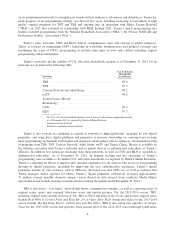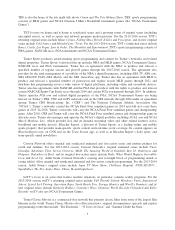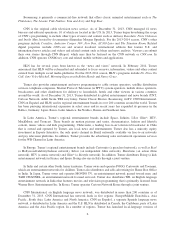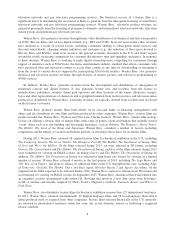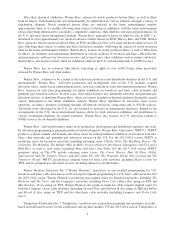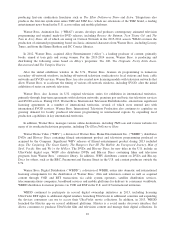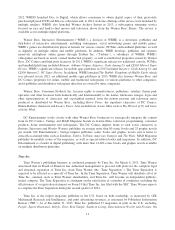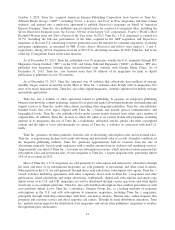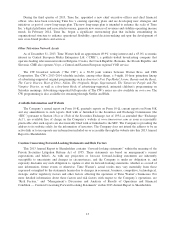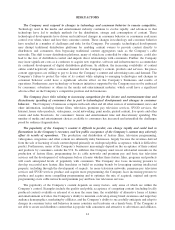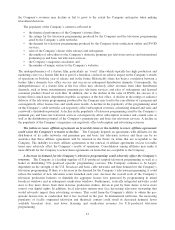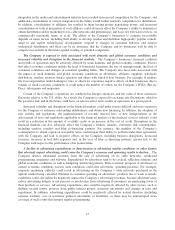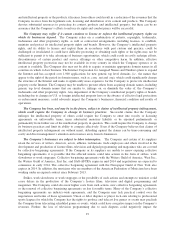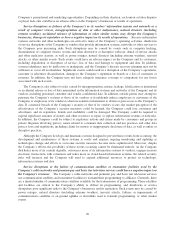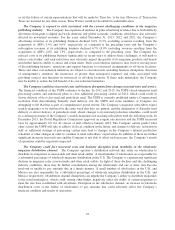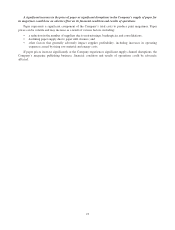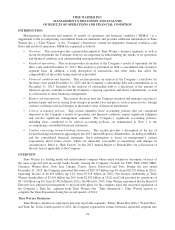Time Magazine 2013 Annual Report Download - page 30
Download and view the complete annual report
Please find page 30 of the 2013 Time Magazine annual report below. You can navigate through the pages in the report by either clicking on the pages listed below, or by using the keyword search tool below to find specific information within the annual report.RISK FACTORS
The Company must respond to changes in technology and consumer behavior to remain competitive.
Technology used in the media and entertainment industry continues to evolve rapidly, and advances in that
technology have led to multiple methods for the distribution, storage and consumption of content. These
technological developments have driven and reinforced changes in consumer behavior as consumers seek more
control over when, where and how they consume content. These changes in technology and consumer behavior
have resulted in a number of challenges and risks for the Company. For example, technological developments
may disrupt traditional distribution platforms by enabling content owners to provide content directly to
distributors and consumers, thus bypassing traditional content aggregators such as the Company’s cable
networks. The shift to new distribution platforms, many of which are controlled by other companies, could also
lead to the loss of distribution control and impede direct relationships with consumers. Further, the Company
may incur significant costs as it continues to acquire new expertise, software and infrastructure to accommodate
its continued development of digital distribution platforms. In addition, the increasing availability of content
online could negatively affect consumer demand for the Company’s content, products and services, the prices
content aggregators are willing to pay to license the Company’s content and advertising rates and demand. The
Company’s failure to protect the value of its content while adapting to emerging technologies and changes in
consumer behavior could have a significant adverse effect on the Company’s businesses and results of
operations. Furthermore, new technology or business initiatives supported by the Company may not be embraced
by consumers, advertisers or others in the media and entertainment industry, which could have a significant
adverse effect on the Company’s competitive position and its businesses.
The Company faces risks relating to increasing competition for the leisure and entertainment time and
discretionary spending of consumers due in part to technological developments and changes in consumer
behavior. The Company’s businesses compete with each other and all other sources of entertainment, news and
other information, including feature films, television, premium pay television services, SVOD services, the
Internet, home video products, videogames, social networking, print media, pirated content, live sports and other
events and radio broadcasts, for consumers’ leisure and entertainment time and discretionary spending. The
number of media and entertainment choices available to consumers has increased and intensified the challenges
posed by audience fragmentation.
The popularity of the Company’s content is difficult to predict, can change rapidly and could lead to
fluctuations in the Company’s revenues, and low public acceptance of the Company’s content may adversely
affect its results of operations. The production and distribution of feature films, television programming,
videogames, magazines and other content are inherently risky businesses, largely because the revenues derived
from the sale or licensing of such content depend primarily on widespread public acceptance, which is difficult to
predict. Furthermore, many of the Company’s businesses increasingly depend on the acceptance of their content
and products by consumers outside the U.S. In addition, the Company must invest substantial amounts in the
production of feature films, programming for its cable networks and premium pay and basic tier television
services and the development of videogames before it learns whether these feature films, programs and products
will reach anticipated levels of popularity with consumers. The Company also faces increasing pressure to
develop successful new feature film franchises or build on existing brands by leveraging existing intellectual
property, including through the development of sequels. As more television networks, premium pay television
services and SVOD services produce and acquire more programming, the Company faces increasing pressure to
produce and acquire more compelling programming and to optimize the mix of acquired, original and sports
programming on its cable networks and premium pay and basic tier television services.
The popularity of the Company’s content depends on many factors, only some of which are within the
Company’s control. Examples include the quality and public acceptance of competing content (including locally
produced content) available or released at or near the same time, the availability of alternative forms of leisure
and entertainment activities, the Company’s ability to maintain or develop strong brand awareness and target key
audience demographics, marketing by affiliates, and the Company’s ability to successfully anticipate and adapt to
changes in consumer tastes and behavior in many countries and territories on a timely basis. If the Company is
not able to create and distribute content that is popular with consumers and attractive to advertisers and affiliates,
14


